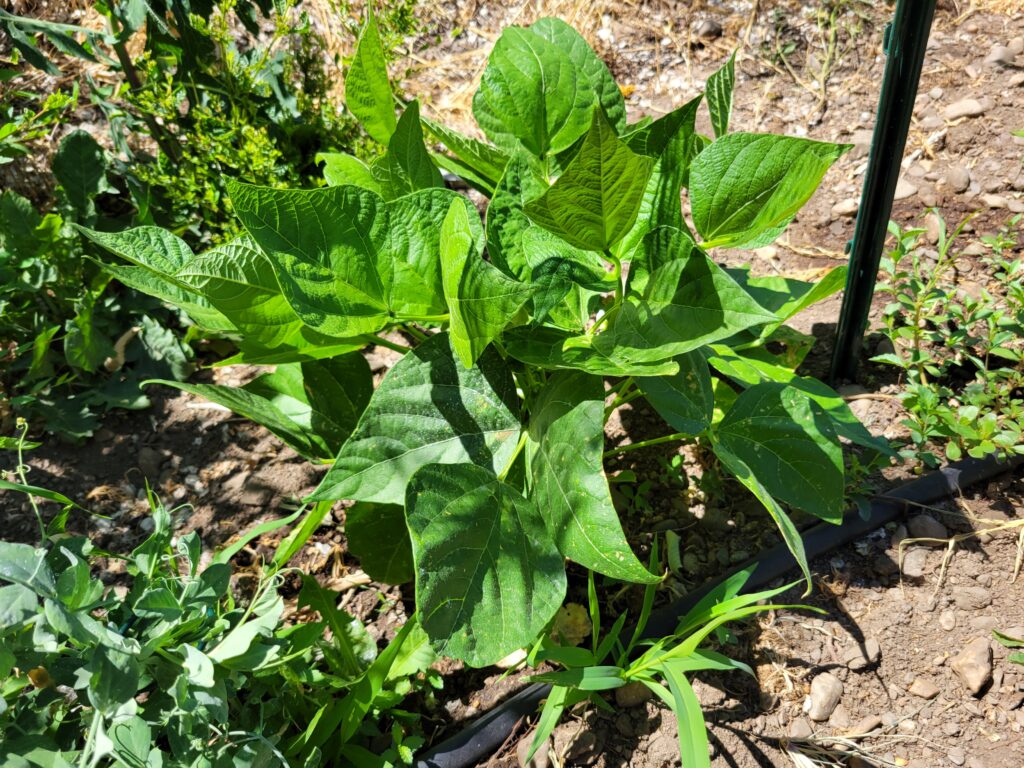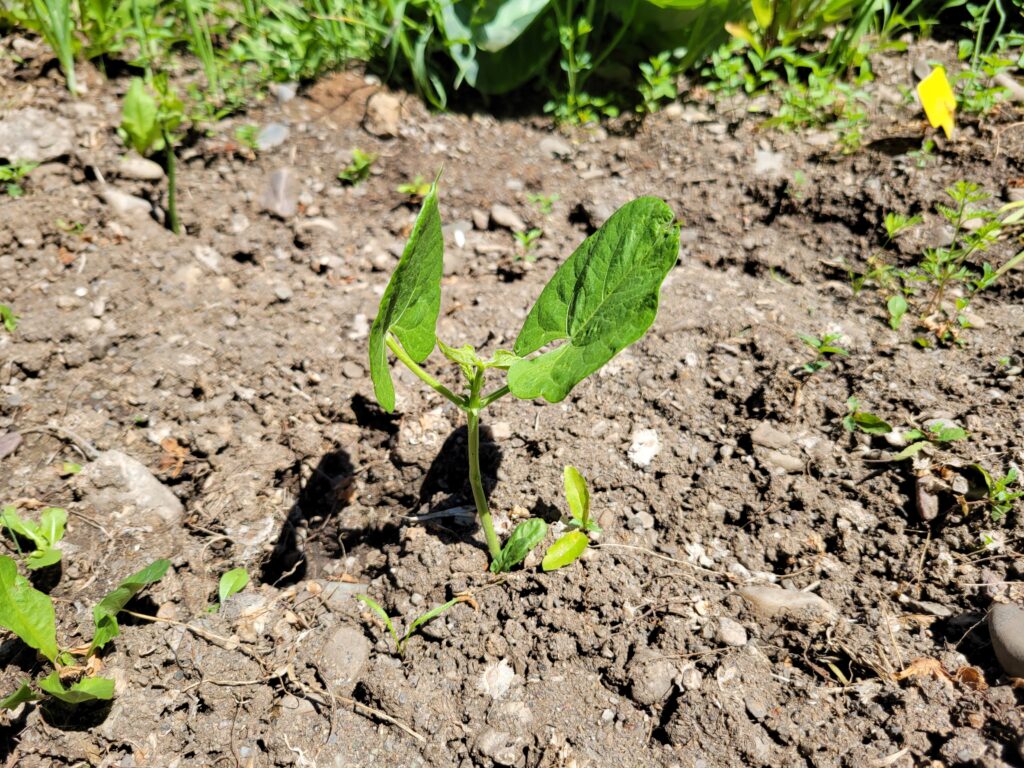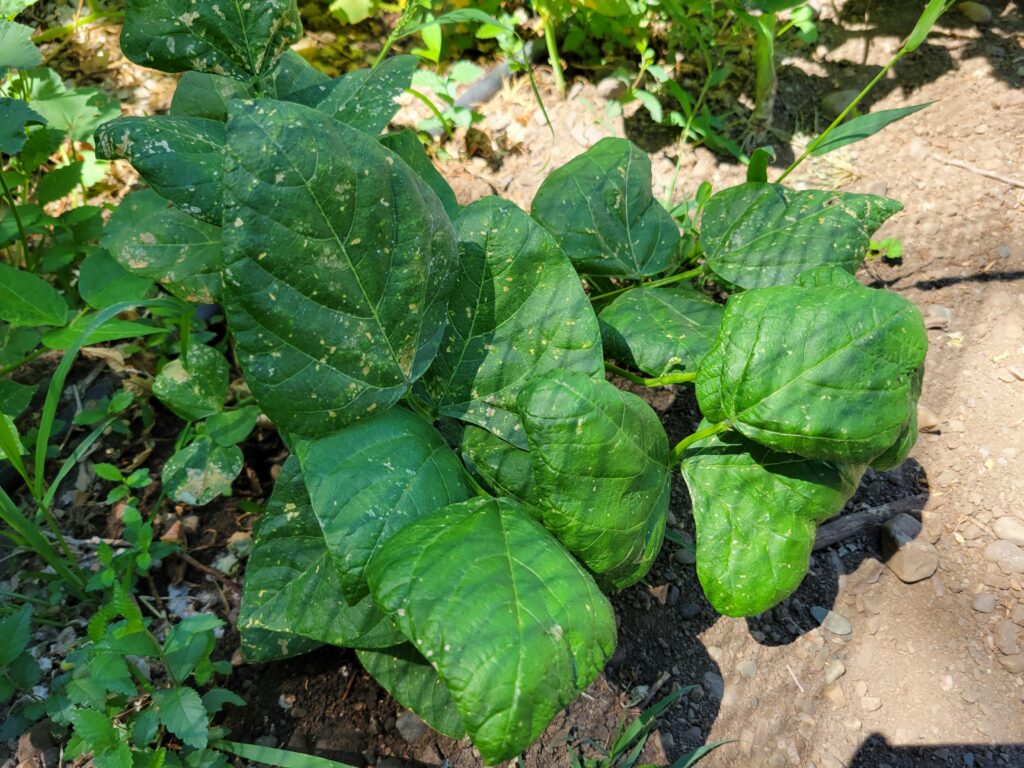There may be affiliate links in this post. If you buy something through one of these links, I’ll get a small commission at no extra cost to you. Please read full disclosure for more information.
If you soak beans before planting them, they will germinate faster and more easily. This means you can harvest your beans earlier!
This year is the first time I’ve grown beans in my garden, and I’m already in love with them. I love their hardiness and their large leaves. Especially when it seems like everything else has daintier and smaller leaves. So the pinto and kidney bean plants are really drawing my attention! They are so tall and bold.
Beans are a great addition to any vegetable garden, and some of them don’t need to be cared for all the time. After all, I do love it when you can set and forget.
Beans are a beloved staple crop for home gardeners Not only are beans packed with protein, fiber and nutrients, they also help fix nitrogen in the soil However, beans have a notoriously poor germination rate when directly sown. This is due to their thick, hard outer seed coat that protects the embryo inside. To boost your bean harvest this season, soaking your seeds before planting is a simple but highly effective technique.
Why Soaking Improves Germination Rates
Dry beans have a water-resistant outer coat evolved to protect the seed This coat prevents water absorption, delaying germination. Beans also contain complex carbohydrates that must be broken down before the seed can sprout Soaking initiates these processes prior to planting by
- Softening the hard outer shell to allow water infiltration
- Beginning the process of carbohydrate breakdown
- Supplying a head start on moisture uptake
Soaked seeds are primed and ready to grow once planted in warm soil. Soaking for the proper duration can significantly increase the speed, consistency and success rate of bean germination.
Optimal Soaking Duration for Common Bean Varieties
Most beans require an overnight soak of 8-12 hours before planting. However, exact soaking times can vary slightly based on bean type.
- Kidney beans: Soak 8-12 hours
- Pinto beans: Soak 8-12 hours
- Black beans: Soak 8-12 hours
- Navy beans: Soak 8-10 hours
- Garbanzo beans (chickpeas): Soak 12-18 hours
- Fava beans: Soak 8-12 hours
- Lima beans: Soak 8-10 hours
- Adzuki beans: Soak 8-10 hours
- Mung beans: Soak 6-8 hours
For most common bean varieties, an overnight soak of 8-12 hours is ideal. Larger beans and beans with thicker seed coats can soak at the longer end of this range.
Soaking Beans in Warm Water Reduces Time
The soaking time can be reduced by using warm water, which more quickly penetrates the seed coat.
- Room temperature water (65°-70°F): 12-24 hours
- Warm water (80°-90°F): 8-12 hours
Make sure the water doesn’t exceed 100°F, as this can damage the seed’s viability. Warm water combined with an overnight soak of 8-12 hours gives beans an optimal head start.
Step-By-Step Guide to Soaking Beans Before Planting
Follow these simple steps for properly soaking beans before sowing:
-
Place bean seeds in a bowl and cover with warm water, about 2-3 inches above the seeds.
-
Allow seeds to soak for 8-12 hours. Most beans will triple in size as they absorb water.
-
Drain the water and rinse the beans thoroughly.
-
Optionally, soak beans for 5-10 minutes in a mild vinegar solution (1 tbsp vinegar per 2 cups water) to prevent disease.
-
Rinse once more before planting directly in warm garden soil.
-
Plant beans 1-2 inches deep in loose soil, spaced 2-4 inches apart.
-
Water gently after planting and keep soil moist until sprouting.
With pre-soaked seeds, beans should begin germinating in 4-6 days. Don’t let seeds soak longer than 24 hours total as they can run out of energy reserves before sprouting.
Other Vegetables That Benefit from Pre-Sowing Soaks
Many vegetables, especially seeds with hard outer coats, can be soaked before planting to improve germination:
- Corn: Soak 8-12 hours
- Squash & pumpkin: Soak 8 hours
- Peas: Soak 8 hours
- Beets: Soak 6-8 hours
- Carrots: Soak 6 hours
- Spinach: Soak 8 hours
- Swiss chard: Soak 8 hours
Even quick-sprouting seeds like lettuce can benefit from a short 4 hour pre-soak. Always use warm water and drain seeds well before planting.
Soaked Seeds Must Go Directly in the Garden
Because soaking initiates the germination process, soaked seeds will quickly lose viability if allowed to dry out. For this reason, direct sow soaked seeds immediately into your garden. Do not soak seeds in advance or attempt to store soaked seeds. For best results, soak seeds overnight and plant out first thing in the morning.
Starting your bean seeds off with a good soak gives them the moisture, head start and vigor boost they need to excel. Employ this simple trick to finally achieve the prolific bean harvest you’ve been waiting for.

Types of Bean Plant Structure:
When these bean plants grow, they bush out, making bushes. These beans can stand on their own without a trellis and are usually not more than two feet tall.

Pole Beans and runner beans are essentially the same. Some people are picky about which way they climb up a trellis, but for my purposes, they are climbing beans. These beans are lovely when trellised over an arch.

Bean pods harvested in their “green” stage are called green beans, string beans, and snap beans. You can buy them in a can at the store and usually find them in the produce section. All green beans will eventually become dry beans if you let them. The longer you wait to harvest, the more fibrous and hard the pod becomes. This creates the hard shell of the dry seeds.
These are the set ’em and forget ’em plant of the garden! These are kind of like potatoes. You plant them, water them a lot, and pick them when they turn brown and fall over. These are dry beans like kidney, black, great northern, and cowpeas. The plant is ready for harvest when the outer shell is brown and dry. Then you can pluck the pods and deshell them in a nice little harvest party!.
Beans are hard seeds. This means that they have a thicker protective coating around the fragile embryo. The seed coat protects the seed from disease, injury, and from drying out. If there is enough water on the seed, the seed coat softens and the embryo can start to grow.
This is the part that I failed to focus on when dealing with these hard-shelled little seeds. When direct sowing without soaking, there is not much water to soften the outer shell. It takes and extended amount of time to get to the point where the embryo can grow. However, you can bypass this process by soaking the seed enough for the germination process to start.

It’s not good to soak for too long. More is usually better, but not here.
Depending on your water temperature, you will have a time period of 8-24 hours. That’s a very long time! Usually, the outer shell will soften faster when the water is warmer. Check on your little seeds. Once you start to feel them plump a little and soften, its time to take them out.
Depending on the water temperature, you can actually speed up the soaking process. Room temperature water will be better for a longer soaking time. 12-24 Hours is the ideal time for soaking seeds in this temperature range.
Warm water is better for a shorter soaking time. Closer to an 8-12 hour soak. Warmer water softens and penetrates the hard coat in less time than room-temperature water.
There is a possibility that you will get a faster germination rate with warmer water as well. However, I am not sure of the actual numbers behind that claim.
Just remember to use warm water and not hot water. You don’t want to cook your beans!

Soak the beans to give them a head start on life and make the bean season last longer. Keep the soil moist but not wet. The best way to tell is if the soil is dry on top but wet when you stick your finger in it a half inch or so.
If the soil is too wet, the seeds will rot and the plant will die. Wet plants after germination are also not good. You can cause the root to rot right off! I might have don’t this a time or few….
Just remember, damp soil is good. Wet soil is not good!

Based on the characteristics of the seeds, they all need different types of environments to germinate. Bean seeds actually benefit from something call scarification.
This is when a small nick or injury to the hard outer shell is present. It allows water to get past the outer shell and absorb into the inner contents of the seed.
Although this also speeds up germination, you don’t need to do it. You can do this in addition to a good soak, but not necessary.
Some seeds are more likely to get diseases when they are soaked because the water quickly breaks down the seed’s natural defenses. Bacterial and fungal infections can happen.

To Soak or Not to Soak Beans
When first starting my bean seeds in little 6-cell planters, I did not soak my beans. I considered looking into whether to soak them or not, but I was impatient and didn’t want to wait. So, I emptied my little seed packet and planted one sweet seed per cell. The seed germination rate was 100%. I was so proud of myself and my new green bean plants! I always thought I had a bad green thumb. It turns out that is not true!.
The seedlings grew and leafed out really nicely.
Like I said before, I fell in love with them.
When it was time to plant my sweet pinto, kidney, and blue lake beans, I was thrilled to see how quickly they grew.
I didn’t harden them off right and probably waited too long to transplant them out. The ones that survived the transplant are definitely stunted.
So, now I will be doing the right thing.
Beans are quite finicky when it comes to their roots and are sensitive as seedlings. This is why my beans are a bit stunted. They just really don’t enjoy being moved. Especially because their natural tendency is to have shallow root systems.
Any maneuvering of the roots is a significant blow.
How I Plant my Green beans// Soak or Not Soak your Beans ??
FAQ
Do I need to soak beans before planting?
What seeds should not be soaked before planting?
Is 2 hours long enough to soak beans?
How do you prepare beans for planting?
Are soaking beans good for plants?
If you are wondering whether or not soaking beans are good for your plants, the answer is YES. It’s best to soak the bean seeds for about 10-24 hours in water before you plant them. Why? When you soak bean seeds in water, it helps seeds sprout, reducing germination time. As a result, your plants can grow quicker and healthier.
How long should a bean be soaked?
Here are a few key things to keep in mind about soaking times for beans: Soak for no longer than 24 hours. Any longer can lead to the exhaustion of food reserves needed for germination and growth. Extended soaking times beyond 24 hours will decrease germination rates. 12-18 hours is an ideal soaking time for most bean varieties.
Should you soak beans before planting?
Please read full disclosure for more information. Soaking beans before planting helps to increase the germination rate, decreases germination time, and allows you a faster harvest! I have been growing beans for the first time in my garden this year and have been falling in love with those sweet plants.
How long should bean seeds be soaked?
Bean seeds may be soaked for up to 24 hours. Soaking longer than 24 hours may decrease the germination rate, & may make the seedlings more susceptible to disease & fungus. Soaking depends on how fast you need them. Even if you do not soak them, they still need a lot of watering when planting.
